As in every three years, The biggest and most important exhibition in the retail field, in Düsseldorf Germany, attracted visitors from all over the world.
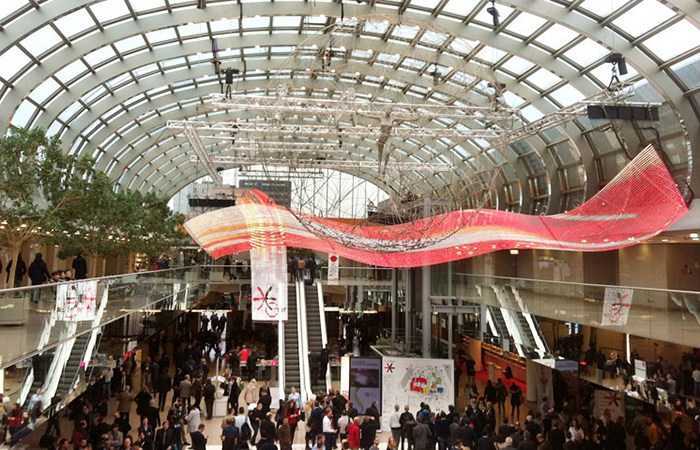
Every three years, the Euroshop Trade Fair, the world’s largest and most important fair for the retail sector that attracts visitors from around the world, is held in Düsseldorf, Germany. In 2014, Euroshop was held on February 16-20 and filled 16 exhibition halls stretching over 107,000 square meters. According to the organizers, 2,036 exhibitors from 53 countries participated, although there were only two exhibitors from Israel. About 105,000 people visited the weeklong fair.
Euroshop provides a platform to exhibit everything retail-related and acts as a sort of extremely broad tool kit for designers, planners and retailers for everything connected to store components and management technology, from shelving systems, heating and cooling infrastructure, and cash registers to an entire world of display fixtures, wall coverings and finishing materials, management and inspection systems, and more.
There were Israeli representatives from almost every retail sector, from owners and managers of independent and chain stores to different design and planning service providers and even local equipment suppliers. This was my third time at the Euroshop Trade Fair and, for me, as a designer and creator of the retail spaces, it was like visiting Disneyland.
In previous years, sometimes new technologies, which were not ready for commercial use, have been featured at the trade show, e.g. interactive interfaces, 3D screens, consumer and product identification technologies, etc. These have tended to be expensive, inaccessible during the exhibition and diverted attention away from immediately useful, but less flashy applications. This year, in the shadow of the global economic crisis, exhibitors came with products and solutions that are more practical, less grandiose and that actually may effectively fill an immediate retail space need.
At this year’s Euroshop, improvements to make products more available and affordable could be seen in just about every area in categories presented in previous years. In addition, within the trade show an international design conference was held, which I will discuss below.
I saw so many interesting things at the exhibition, but I want to focus on a few striking examples from the countless things I saw. The example below, while they may seem insignificant, in my opinion will have a decisive impact on design and the customer experience in retail spaces and in improving the shopping process.
Improved Self-Service Checkout: These follow the same self-checkout model available in Israel at Shufersal supermarkets. These self-service checkouts have not caught on in most chains, in part because they force the customer to act as the uncompensated cashier and bagger, but also because the existing systems often have glitches. At Euroshop, a new generation of self-service checkout systems was exhibited that uses a mature version of existing technology and demonstrates the future direction of self-service checkouts. The basic principle is the same but instead of scanning barcodes, the customer just places the products on a moving belt, which also acts as a scale, and the products are scanned independently while they move along the belt. All the customer has to do is to bag the products and pay. The system’s limitation is that currently a maximum of 15,000 products can be listed in the system, but this is likely to grow soon.
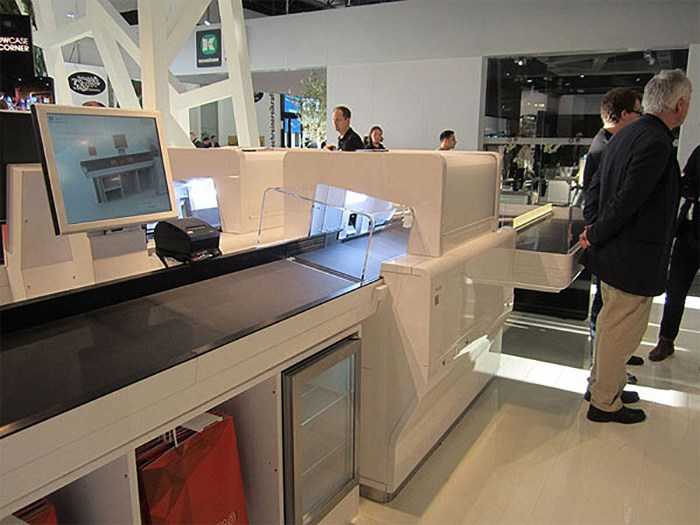 An improved self - service checkout system.
An improved self - service checkout system.Changes to shelf dimensions and height
Anyone who has set up a food store will appreciate the significant improvements available now to the thickness and height of product shelving.
Currently, shelving systems start at a level of about 15 cm (5.9 inches) from the floor, with shelf thickness of about 3 cm (1.2 inches). The shelving system displayed at Euroshop 2014 has shelves that are 1 cm (0.4 inches) thick and start closer to the floor, which will allow stores to add more shelving.
This means that a store can include 15 percent more products in the same space!
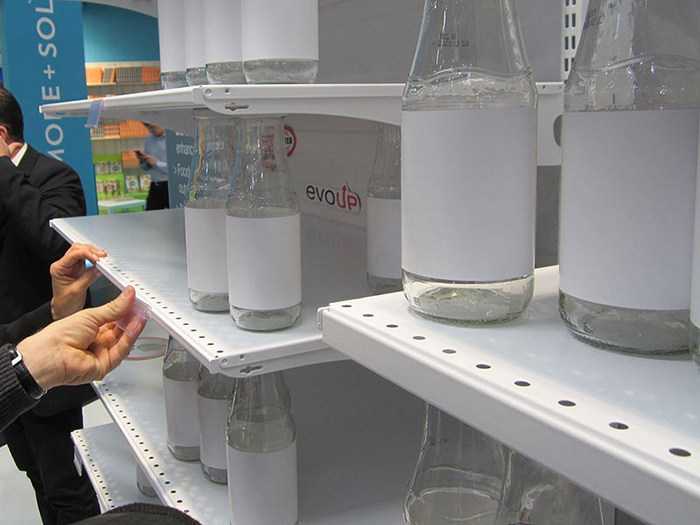 Changes being made to the thickness and height of shelves.
Changes being made to the thickness and height of shelves.Improvements to cooling systems
Cooling systems, which are a store’s most complex and expensive system, require improvements in energy efficiency, to their display screens and their ease of operation and maintenance. ARNEG is one company that really stood out for the variety of its smart solutions, including a variety of independent cooling systems and a new generation of cooling split systems that are narrower and more economical.
Advanced modeling software
Due to technological improvements, on display were complex surfaces and bold design like never before at unprecedented prices and availability. Geometrically complicated and multi-planar designs at a range of costs allow immediate application of technology to meet almost every budget.
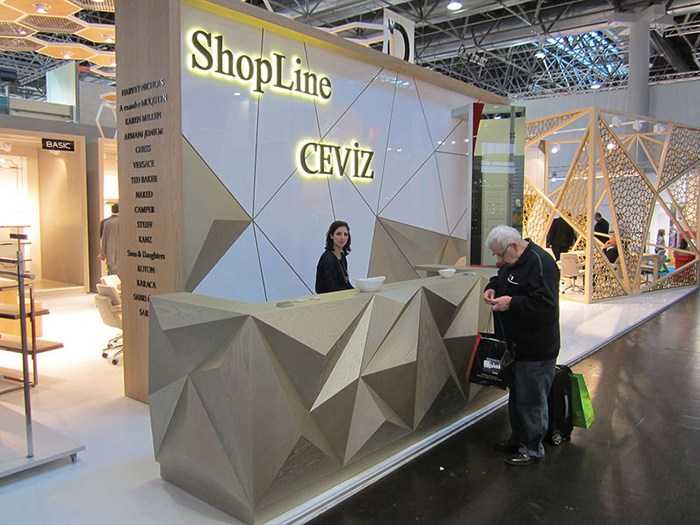 Products from advanced modeling software.
Products from advanced modeling software.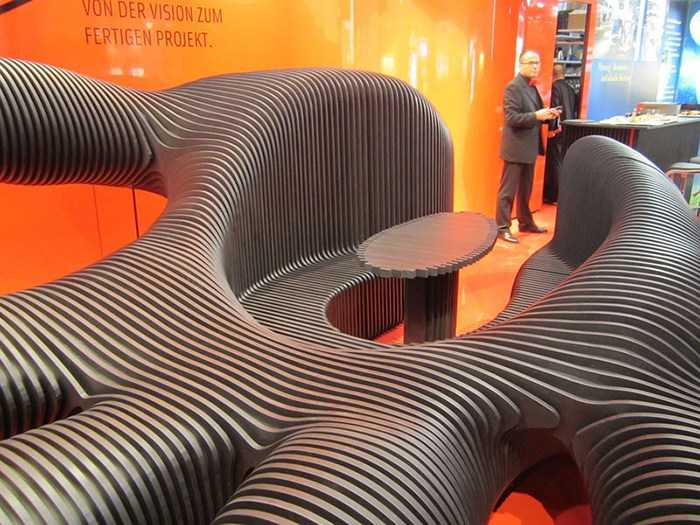 Products from advanced modeling software.
Products from advanced modeling software.Electricity
There was a terrific new technology that converts 220V voltage and wireless LAN through a busbar. This technology used to be only available for lighting fixtures but now can be used with all sorts of infrastructure. The busbar does not require prior planning or complicated changes for feeds.
The new busbar is revolutionary! I hope the Standards Institution of Israel will approve the system quickly.
Improved LEDs
LEDs have improved every aspect of systems being used today. The improved LEDs are easy to install on shelving systems, can be used in huge, flexible surfaces for full graphic displays that can be walked on, and have been improved generally and their costs for in the integration in a store’s fixtures reduced.
 Improved LED systems.
Improved LED systems.Small manufacturers
Accessing small manufacturers via the internet is becoming easier with each passing year. Euroshop 2014 had a number of boutique manufacturers from around the world exhibiting in every retail area, with prices to meet every budget and the option to order in small quantities. For example, there were signage letters from Japan – the best that I saw – and clothing stores mannequins that can be designed to order, branded carpeting from Italy and many, many others.
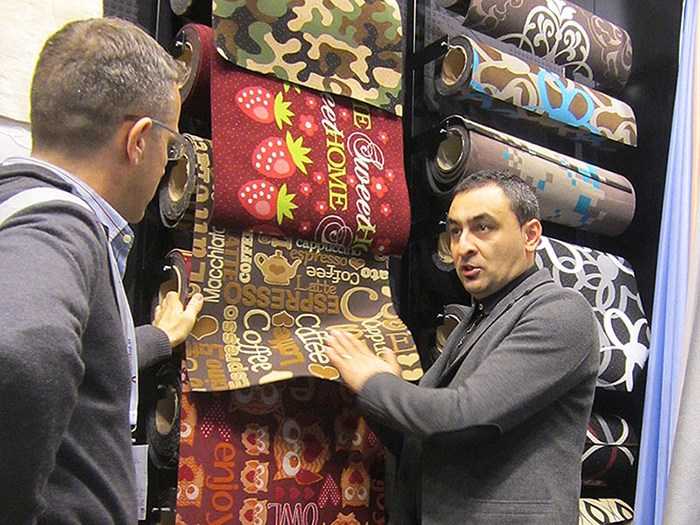 Branded carpeting from Italy.
Branded carpeting from Italy.Gimmicks
Of all the gimmicks available, there were two that particularly stood out: an innovative fountain that can be programmed so its water sprays create text or an image in the air; and the widespread use of Xbox sensors to create an interactive interface with a motion or animated display.
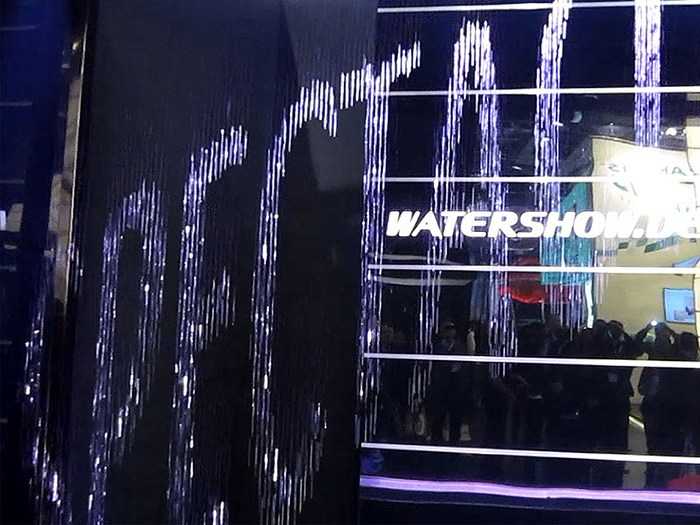 Waterfall gimmick.
Waterfall gimmick.Design & Build
A niche that was once marginal but that has developed into its own category is the full-service provider, that is, one company that unifies all the retail aspects of a sales space and provides turn-key project services, from the retail concept itself to all the interior, industrial and graphic design, and production and installation.
As a personal advocate for this approach, it was a pleasure to see that “design & build” is becoming accepted globally and is continuously expanding, and that firms that provide this service are becoming key players in commercial design.
 Vegabond style hotel designAll right reserved to The Water House at South Bund, Photo courtesy of Pedro Pegenaute.
Vegabond style hotel designAll right reserved to The Water House at South Bund, Photo courtesy of Pedro Pegenaute.Predicting Trends – Ms. Li Edelkoort
Only two Israelis participated in Euroshop’s concurrent design conference, and I highly recommend to anyone who will attend Euroshop in the future to make time to attend lectures given by global market leaders. Aside from the speakers who presented impressive projects from around the world, and presentations from the exhibition’s winners, the speaker who really stood out was Ms. Li Edelkoort, who is accepted as the world’s Number One expert at spotting trends. Ms. Edelkoort was born in the Netherlands and today lives in Paris. She is familiar to certain circles in Israel and even curated an exhibition at the Holon Museum of Design. At Euroshop, she presented retail ideas that will mature in the coming years. It was fascinating and inspiring to hear her retail insights that integrate data, cultural dynamics and her developed intuition. Among the many examples, she noted the development of niche food shops, e.g. a bread shop or wine shop in contrast to supermarkets and how the same trend will develop in fashion retail, e.g. a niche clothing store that only sells button-down shirts instead of general clothing stores, in response to a slowly developing retail need. On the other hand, an example was given of the development of multi-service stores, such as a wedding store where a bride and groom might both buy their clothing and a whole range of wedding items, from invitations to tablecloths for the reception. These stores would develop to meet the customer’s real needs and in response to, in her opinion, the development of the customer’s preferences. In terms of styling, she presented a currently esoteric niche that will become more prominent and mainstream: the vagabond style. Following the economic crisis, when normative individuals began to experience economic hardship, it has become easier for us to identify with beggar situation and their aesthetic. Ms. Edelkoort presented a “vagabond-style” hotel and “vagabond-style” fashion.